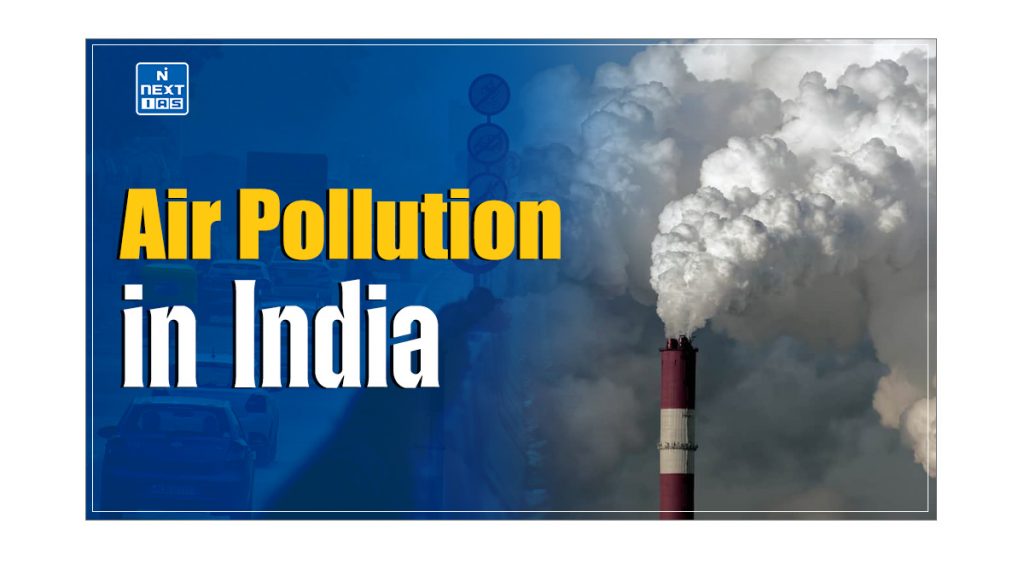
Air pollution in India is a significant environmental issue, impacting public health, economic productivity, and the overall quality of life. Rapid industrialization, urbanization, and increased vehicle emissions over the past few decades have exacerbated this problem. This article aims to provide a comprehensive overview of air pollution in India, its severity, major causes, consequences, control measures taken, and related concepts.
What is Air Pollution?
- Air Pollution is the contamination of the atmosphere with harmful substances that can adversely affect human health, ecosystems, and climate.
- The contaminating substances that cause air pollution are called Air Pollutants.
- These substances can be gases, particles, or a combination of both and come from various sources.
- Air Pollution is one of the prominent types of Environmental Pollution.
| What is Environmental Pollution? – Environmental Pollution refers to the introduction of harmful materials into the environment. – In other words, it is the contamination of the physical and biological components of the environment to such an extent that normal environmental processes are adversely affected. – Environmental pollution can be categorised into several types based on the nature of the pollutants and the media they affect, including Air Pollution, Soil Pollution, Water Pollution, etc. |
| Read our detailed articles on: 1. Environmental Pollution 2. Soil Pollution 3. Water Pollution 4. Noise Pollution 5. Thermal Pollution 6. Nuclear Pollution 7. Marine Pollution 8. Plastic Pollution |
Severity of Air Pollution in India
- Air quality in India has deteriorated significantly over the past two decades.
- India’s current air pollution levels are among the highest in the world, posing a heavy threat to the country’s health and economy.
- In 2021, around 97 per cent of the country’s population was exposed to particulate matter (PM2.5) in excess of the value specified by the World Health Organization (WHO) air quality guidelines, making them vulnerable to serious health risks.
- The rate at which air pollution, especially urban, has been growing across India is a cause of concern.
- Most cities fail to meet health-based standards due to deteriorating air quality.
- Almost all cities are reeling under severe particulate pollution, while newer pollutants like nitrogen oxides and air toxics have begun to add to the public health challenge.
- Interestingly, even small and medium-sized cities are seeing a phenomenal rise in pollution.
Effects of Air Pollution in India
Air pollution in India poses grave, multi-faceted risks to India and its people. Some of the major effects of air pollution in India are as follows:
- Health Effects
- Air pollution in India poses serious health risks, including respiratory diseases such as asthma and chronic bronchitis, cardiovascular conditions, and premature mortality.
- Air pollution in India increases mortality and morbidity rates.
- A 2018 report by the Health Effects Institute projects a rise in annual deaths due to air pollution in India from 1.1 million in 2015 to 1.7 million in 2030.
- Environmental Effects
- Air pollution in India adversely affects ecosystems by contaminating soil and water bodies, damaging vegetation, and impacting wildlife.
- High concentrations of sulfur dioxide and nitrogen oxides can lead to Acid Rain, which has environmental impacts.
- Some air pollutants, such as greenhouse gases (e.g., carbon dioxide and methane), contribute to global warming and climate change.
- Economic Effects
- Air pollution in India can have significant economic costs, manifesting in various forms.
- Air pollution in India reduces agricultural productivity and yields by damaging the soil.
- Air pollution in India also rapidly increases public health expenditure due to increased health issues.
- Exacerbated health issues also lead to diminished labour productivity.
- Estimates peg the economic cost of air pollution to the Indian economy at more than $150 billion annually.
Measures Taken to Control Air Pollution in India
To control air pollution in India and minimise its impacts, the Government of India has taken the following measures:
- The Air (Prevention And Control of Pollution) Act, 1981, has been enacted to provide a legislative framework for air pollution control measures.
- The Central Pollution Control Board (CPCB) and State Pollution Control Boards (SPCBs) have been entrusted with the functions and powers to monitor air quality nationwide.
- The Government has notified the National Ambient Air Quality Standards 2009, which envisages 12 pollutants to indicate the levels of air quality.
- Setting up a monitoring network to assess ambient air quality in different cities.
- Introducing cleaner or alternate fuels like CNG, LPG, and bio-diesel (B20) is also essential.
- Strengthening public transport networks, including Metro and Bus Rapid Transit System (BRTS).
- Setting up of common pollution control facilities for industrial pollution control.
- Rollout of Bharat Stage VI norms have been enforced all over the country since 2020.
- Stringent industrial standards have been formulated and notified for public/stakeholder comments.
- Environment clearances have been made compulsory for developmental projects. Also, public hearings have been made an important component of the Environmental Impact Assessment process.
- Environmental audits have been made compulsory for all polluting industries.
- Introduction of Green Crackers, Smog Towers, etc.
| The Supreme Court of India declared the “right to a decent environment, including pollution-free water and air” as a fundamental right under Article 21 (right to life) in the MC Mehta vs. Union of India, 1988 Case. |
| In 2020, based on the recommendations of the 15th Finance Commission, the Government of India has set aside about $1.7 billion to fight air pollution in India over the next five years for the 42 Indian cities with million-plus populations—provided they reduce their air pollution levels by 15 per cent every year. This is the world’s first performance-based fiscal transfer funding program for city air quality management. |
Air Quality Index (AQI)
- The AQI is a ‘One Number-One Colour-One Description’ of air quality information that allows the common man to judge the air quality within his vicinity.
- It simplifies air quality information that is easily understood by a common person.
- The formulation of the index was a continuation of the initiatives under the Swachh Bharat Mission.
Pollutants Covered under Air Quality Index (AQI)
- Under the AQI, an effort has been made to include a comprehensive set of parameters.
- While the earlier measuring index was limited to just three indicators, the addition of five additional indicators has made the AQI quite comprehensive.
- Thus, the AQI will consider eight pollutants (PM10, PM2.5, NO2, SO2, CO, O3, NH3, and Pb) for which short-term (up to 24-hour averaging period) National Ambient Air Quality Standards are prescribed.
- A sub-index is calculated for each of these pollutants based on the measured ambient concentrations, corresponding standards, and likely health impact.
AQI Categories
Under the Air Quality Index (AQI), air quality is reported under 6 AQI categories: Good, Satisfactory, Moderately polluted, Poor, Very Poor, and Severe.
| AQI | ASSOCIATED HEALTH IMPACTS |
|---|---|
| Good (0-50) | Minimal Impact |
| Satisfactory (51-100) | May cause minor breathing discomfort to sensitive people. |
| Moderately polluted (101-200) | May cause breathing discomfort to people with lung diseases such as asthma, and discomfort to people with heart disease, children and older adults. |
| Poor (201-300) | It may cause breathing discomfort to people on prolonged exposure and discomfort to people with heart disease |
| Very Poor (301-400) | It may cause respiratory illness in people with prolonged exposure. The effect may be more pronounced in people with lung and heart diseases. |
| Severe (401-500) | May cause respiratory impact even on healthy people, and serious health impacts on people with lung/heart disease. The health impacts may be experienced even during light physical activity. |
National Clean Air Programme (NCAP)
- The National Clean Air Programme (NCAP) was launched in 2019 as a long-term, time-bound, national-level strategy to tackle the country’s air pollution problem comprehensively.
- It aims to augment the air quality monitoring network nationwide and strengthen awareness and capacity-building activities.
- It aims to achieve a 20-30% reduction in Particulate Matter concentrations by 2024, keeping 2017 as the base year for comparing concentrations.
- Recently, the centre has set a new target of a 40% reduction in PM concentration in cities covered under NCAP by 2026.
Read our detailed article on the National Clean Air Programme (NCAP).
Commission for Air Quality Management (CAQM)
- The Air Quality Management in National Capital Region and Adjoining Areas Act, 2021, was passed on 12 August 2021 to set up a Commission that provides for better coordination, research, identification, and resolution of problems related to air quality in the National Capital Region (NCR) and adjoining areas.
- Adjoining areas have been defined as areas in the states of Haryana, Punjab, Rajasthan, and Uttar Pradesh adjoining the NCR where any source of pollution may adversely impact air quality in the NCR.
Comprehensive Action Plan (CAP)
- The Comprehensive Action Plan (CAP) is a long-term plan to address the issue of air pollution (especially in Delhi-NCR).
- It aims to meet ambient air quality standards in the National Capital Territory of Delhi and the National Capital Region, including the states of Haryana, Rajasthan and Uttar Pradesh.
- The guiding principles of the plan are:
- Meet clean air standards in a time-bound manner
- Take action on all sources of pollution to meet clean air targets
- Reduce integrated exposure to protect public health
- Public health risks from air pollution are grave and growing
- Address quantum vs toxicity
- Adopt a regional approach for a common air-shed
- Enforce emergency action to control and minimise exposure daily
- Addressing both consistent and seasonal sources of pollution
- Address secondary particulates that are formed in the air by gases.
- The aim is not to create new institutions but to make the current institutional arrangements mandated by the Hon’ble Supreme Court for implementing the Graded Response Action Plan and by the Hon’ble National Green Tribunal for air pollution control in the region responsible for implementing the action plan.
- The following institutional arrangement is proposed for the implementation of the Comprehensive Action Plan:
- Central-level Committee under the Secretary, Ministry of Environment, Forests and Climate Change to oversee implementation at the NCR level
- State-level committees under the Chief Secretary to oversee implementation at the state level
- CPCB-Task Force will monitor air quality and inform Central and State Committees and the EPCA about the need to implement measures under the Graded Response Action Plan.
- Directions under the Graded Response Action Plan include monitoring critical milestones in the comprehensive action plan and preparing special reports on key steps to guide action by EPCA—regular compliance reports to the Hon’ble Supreme Court.
Graded Response Action Plan (GRAP)
- The Graded Response Action Plan (GRAP) is a methodical strategy to prevent Delhi-Air NCR’s quality from deteriorating.
- It was developed in 2017 in collaboration with the Delhi government and the Environmental Pollution Prevention and Control Authority (EPCA).
- It is an emergency response mechanism that is only enforced when air pollution reaches a certain threshold. The plan is incremental and adaptable, which means the preventive measures will be updated and escalated according to changes in the AQI.
- GRAP measures are categorised by stages: moderate to Poor, Very Poor, severe, severe-plus, or Emergency.
- The GRAP requires action and coordination among 13 different agencies from Delhi, Uttar Pradesh, Haryana, and Rajasthan, including the respective state governments, state pollution control boards, traffic police, Central Public Works Department, and Petroleum and Explosives Safety Organisations (PESOs) from each state.
Suggested Measures to Tackle Air Pollution in India
Some of the steps that could help control air pollution in India are as follows:
- Emphasis on Clean Energy Resources: The government of India has been incentivising clean energy technologies like solar, wind, and geothermal energy to curb air pollution.
- Use of Energy-Efficient Devices: For example, LED bulbs consume less electricity than traditional bulbs. They have a longer life and help reduce pollution by consuming less energy.
- Use of Public Mode of Transportation: Carpooling is on the rise as awareness of air pollution increases.
- Conserving Energy: Behavioral change will foster energy efficiency in the home and industrial establishments.
- Emission Norms: Better traffic management and timely implementation of the emission norms will go a long way in curbing air pollution.
- Green Corridors: The development of green belts across the highways and transportation lines will reduce the harmful effects of pollution.
Conclusion
Air pollution in India remains a critical challenge, damaging the environment and public health. Tackling this menace necessitates a multifaceted approach to addressing its causes and mitigating its effects. Through stringent regulations, technological advancements, public awareness, and collective efforts, India can achieve the goals of cleaner air and a healthier environment.
Frequently Asked Questions (FAQs)
What are air pollutants?
Air pollutants are harmful substances released into the atmosphere, causing damage to the environment and human health. These include particulate matter (PM), carbon monoxide (CO), nitrogen oxides (NOx), sulfur dioxide (SO2), ozone (O3), and volatile organic compounds (VOCs).
What are the 7 main causes of air pollution?
The seven main causes of air pollution are:
– Vehicle emissions – Exhaust from cars and trucks.
– Industrial activities – Factories and power plants releasing pollutants.
– Burning fossil fuels – Coal, oil, and gas for energy.
– Agricultural activities – Pesticides, fertilisers, and livestock.
– Deforestation – Reducing trees that absorb CO2.
– Waste disposal – Burning and decomposition of waste.
– Natural events – Wildfires, volcanic eruptions, and dust storms.
What are the effects of air pollution in India?
Air pollution in India severely affects public health, the environment, and the economy. It leads to respiratory diseases, heart conditions, and premature deaths.






